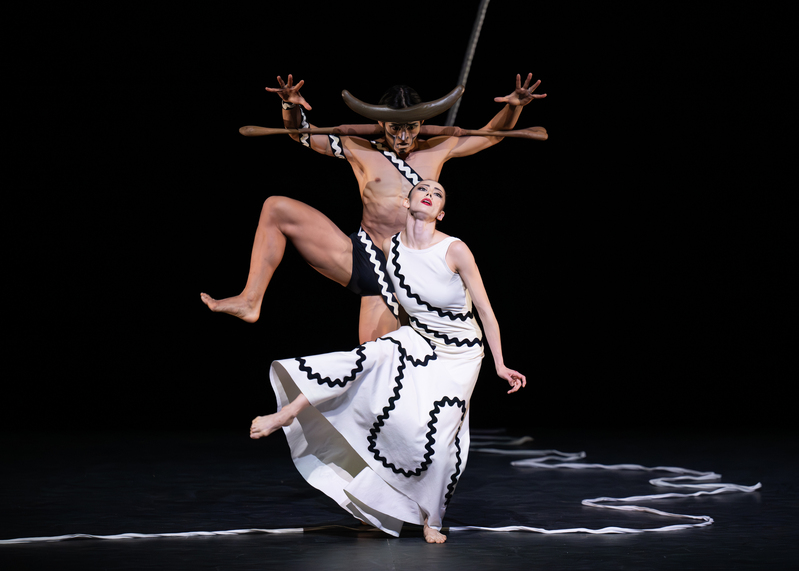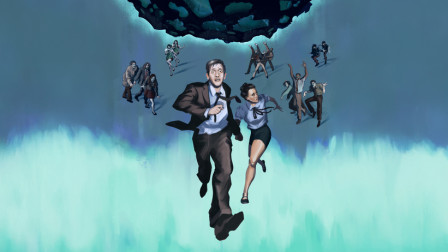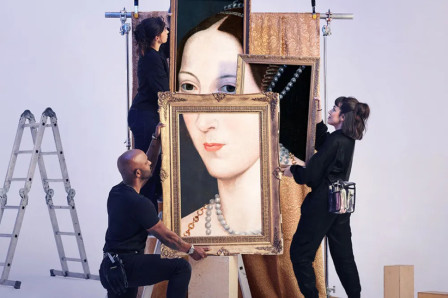Review: R:EVOLUTION at Sadler’s Wells
English National Ballet are currently occupying Sadler’s Wells with their composite production entitled R:EVOLUTION. Waxing lyrically about the show, ENB’s artistic director Aaron S. Watkin’s intention was to show the vibrant evolution of the art form by presenting works that ignite emotions, thereby inviting audiences to feel more. As with all such efforts, there were highs and lows.
 Photo by ASH.
Photo by ASH.
The dance programme is presented in four distinct parts, with each representing a groundbreaking choreographic milestone which celebrates the work of four individuals of renown: George Balanchine’s Theme and Variations and Martha Graham’s Errand into the Maze were both first presented in New York City in 1947. They are followed by William Forsythe’s Herman Schmerman (Quintet) from 1992 and finally, David Dawson’s Four Last Songs which premiered at Sadler’s Wells in 2023.
Theme and Variations — 26 dancers took to the stage adorned in ultra traditional garb of tutus and tights, evoking the great classical Russian period over which Tchaikovsky’s influence was fundamental. Whilst largely abstract, the piece owes much to The Sleeping Beauty in style. Principal Alice Mariani executed superb technique, with less reassured support from Ricardo Castellanos. Unfortunately, the traditional costume requires the corps members to wear tiaras, one of which became entangled during a particularly obvious moment. Tugged loose, it dropped to the floor and was discretely kicked up stage, where it remained for the entirety of the first piece. Wardrobe malfunctions happen!
Errand into the Maze — Lasting just 15 minutes and taking place on a stylised set redolent of Isamu Noguchi’s original staging, Graham used the Greek minotaur myth as the basis for her piece for two dancers. The first is The Woman (essentially Ariadne with her golden thread) entering the labyrinth, while the second is The Creature of Fear who appears horned and demonic. Emily Suzuki conveyed both the terror and manipulative power of her part, as she eventually subdues the beast played with athleticism and menace by Rentaro Nakaaki.
Herman Schmerman — Most recently seen as part of ENB’s April outing at Sadler’s with The Forsythe Programme, the stylised and disjointed nature of the choreography requires considerable point work and tight technique when paired with Thom Willems' musical accompaniment. Aitor Arrieta and Rhys Antoni Yeomans provided a playfully serious foil to the female dancers with Alice Bellini and Swanice Luong making particularly effective use of their differing heights in the trios.
Four Last Songs — Saving the best until last, there is an elusive poetic humanity in David Dawson’s choreography which deploys the music of Richard Strauss. Sung in four sections — Frűhling, September, Beim Schlafengehen and Im Abendtrot — soprano Madeleine Pierard remains on stage throughout, dressed in dark black velvet, emulating the shadowy depths of Eno Henze's staging design. The profound sense of our irrelevance (given the eternity which preceded us and the eternity which will follow after we are gone), acts to neutralise anything but the contribution we each make to something much greater and more magnificent than our individual selves. As such, the piece becomes almost spiritual and epiphanic as the dancers engage in lift work and runs to suggest the ephemeral and natural. Sangeun Lee and Emma Hawes both shone particularly bright in the female parts. Whilst Daniel McCormick and Lorenzo Trossello frequently adjusted their physicality to guide and blend the more obvious misalignments (particularly arms) of other male dancers.
R:EVOLUTION provides an evening of dance variety and continues at Sadler’s Wells until 11th October with a running time of a little over 2 hours, which includes two 20 minute intervals.
Latest News

 StarKid announces West End run for 2026
17 November 2025 at 10:26
StarKid announces West End run for 2026
17 November 2025 at 10:26

 Almeida Theatre's 1536 to transfer to the West End
17 November 2025 at 09:46
Almeida Theatre's 1536 to transfer to the West End
17 November 2025 at 09:46

 GERRY AND SEWELL to transfer to the West End
14 November 2025 at 10:02
GERRY AND SEWELL to transfer to the West End
14 November 2025 at 10:02

 Rehearsal images released for HMS PINAFORE starring Mel Giedroyc
14 November 2025 at 09:29
Rehearsal images released for HMS PINAFORE starring Mel Giedroyc
14 November 2025 at 09:29
